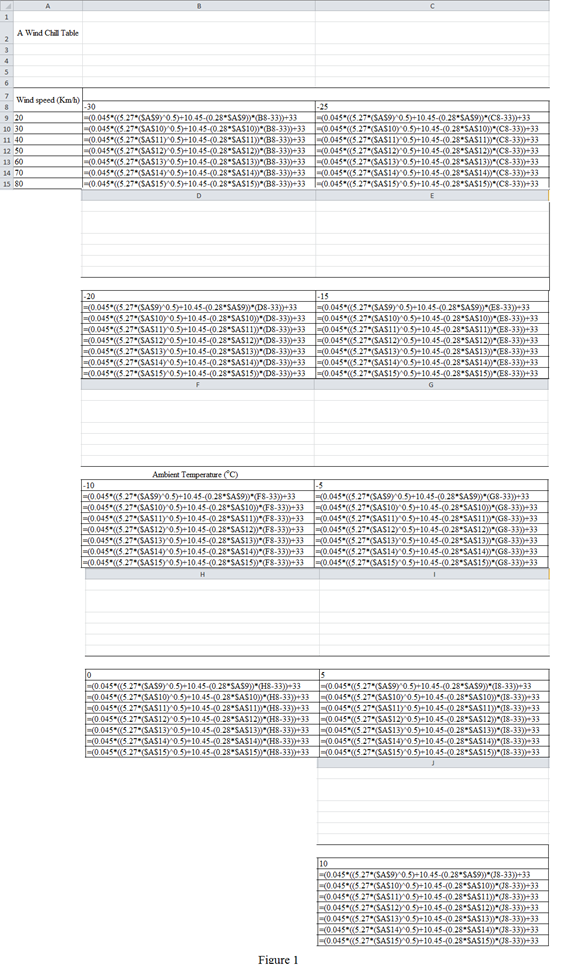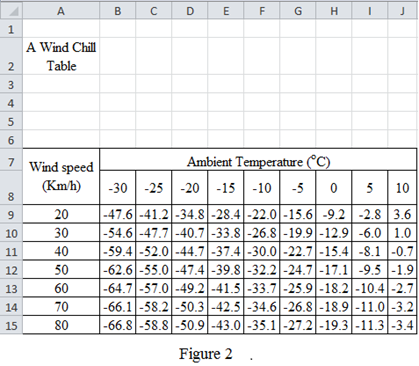
Concept explainers
Create a table that shows the windchill temperatures for the given range of ambient air temperature and wind speed.
Answer to Problem 19P
A table is created for the windchill temperatures with the given range of ambient air temperature and wind speed by using excel.
Explanation of Solution
Given data:
The range of ambient air temperature is
The range of wind speed is
Formula used:
Formula to calculate the more common equivalent windchill temperatures is,
Here,
Calculation:

Refer to the Figure 1:
Column A shows the wind speed (V) with range from
For the cell B9, the formula used to find the equivalent windchill temperatures as “
Written as “=(0.045*((5.27*($A$9)^0.5)+10.45-(0.28*$A$9))*(B8-33))+33”. Here, B8 cell represents the value of ambient air temperature is
For the cell B10, the formula used to find the equivalent windchill temperatures as “
Written as “=(0.045*((5.27*($A$10)^0.5)+10.45-(0.28*$A$10))*(B8-33))+33”. Here, B8 cell represents the value of ambient air temperature is
For the cell B11, the formula used to find the equivalent windchill temperatures as “
Written as “=(0.045*((5.27*($A$11)^0.5)+10.45-(0.28*$A$11))*(B8-33))+33”. Here, B8 cell represents the value of ambient air temperature is
For the cell B12, the formula used to find the equivalent windchill temperatures as “
Written as “=(0.045*((5.27*($A$12)^0.5)+10.45-(0.28*$A$12))*(B8-33))+33”. Here, B8 cell represents the value of ambient air temperature is
For the cell B13, the formula used to find the equivalent windchill temperatures as “
Written as “=(0.045*((5.27*($A$13)^0.5)+10.45-(0.28*$A$13))*(B8-33))+33”. Here, B8 cell represents the value of ambient air temperature is
For the cell B14, the formula used to find the equivalent windchill temperatures as “
Written as “=(0.045*((5.27*($A$14)^0.5)+10.45-(0.28*$A$14))*(B8-33))+33”. Here, B8 cell represents the value of ambient air temperature is
For the cell B15, the formula used to find the equivalent windchill temperatures as “
Written as “=(0.045*((5.27*($A$15)^0.5)+10.45-(0.28*$A$15))*(B8-33))+33”. Here, B8 cell represents the value of ambient air temperature is
Table 1 is created to shows a Wind Chill Temperature.
Table 1
| Wind speed (Km/h) | Ambient Temperature | ||||||||
| -30 | -25 | -20 | -15 | -10 | -5 | 0 | 5 | 10 | |
| 20 | -47.6 | -41.2 | -34.8 | -28.4 | -22.0 | -15.6 | -9.2 | -2.8 | 3.6 |
| 30 | -54.6 | -47.7 | -40.7 | -33.8 | -26.8 | -19.9 | -12.9 | -6.0 | 1.0 |
| 40 | -59.4 | -52.0 | -44.7 | -37.4 | -30.0 | -22.7 | -15.4 | -8.1 | -0.7 |
| 50 | -62.6 | -55.0 | -47.4 | -39.8 | -32.2 | -24.7 | -17.1 | -9.5 | -1.9 |
| 60 | -64.7 | -57.0 | -49.2 | -41.5 | -33.7 | -25.9 | -18.2 | -10.4 | -2.7 |
| 70 | -66.1 | -58.2 | -50.3 | -42.5 | -34.6 | -26.8 | -18.9 | -11.0 | -3.2 |
| 80 | -66.8 | -58.8 | -50.9 | -43.0 | -35.1 | -27.2 | -19.3 | -11.3 | -3.4 |
Figure 2 shows a wind chill table in the excel sheet has obtained as similar to given Problem 14.19 in the textbook

Conclusion:
Hence, a table is created for the windchill temperatures with the given range of an ambient air temperature, and wind speed have been explained using excel.
Want to see more full solutions like this?
Chapter 14 Solutions
Engineering Fundamentals: An Introduction to Engineering (MindTap Course List)
- Using the information given in Table 10.4, determine the ratio of local pressure and density to sea-level values. Estimate the value of air density at the cruising altitude of most commercial airliners. Altitude (m) sealevel PPsealevel 0 (sea level) 1000 3000 5000 8000 10,000 12,000 14,000 15,000arrow_forwardPlease help me answer this question and please show the solution for each indicated problem. A pitcher throws a fast ball that is moving at a speed of 80 mph. The batter hits the ball in the direction shown. The ball leaves the bat at a speed of 190 mph. If the bat and the ball are in contact for 0.030 seconds, determine the average impulse force exerted on the ball by the batter during the impact. The ball weighs 0.40 lbs.arrow_forward
 Engineering Fundamentals: An Introduction to Engi...Civil EngineeringISBN:9781305084766Author:Saeed MoaveniPublisher:Cengage Learning
Engineering Fundamentals: An Introduction to Engi...Civil EngineeringISBN:9781305084766Author:Saeed MoaveniPublisher:Cengage Learning
